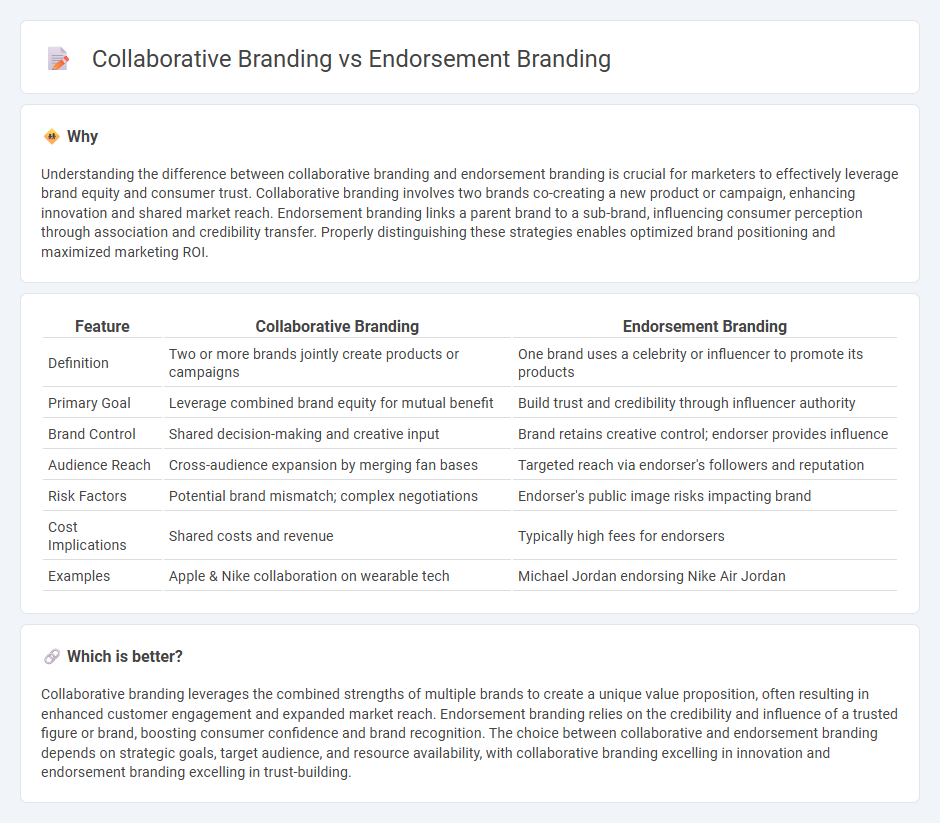
Collaborative branding merges two or more brands to create a unified product or campaign, enhancing market reach and consumer appeal through shared values and innovation. Endorsement branding involves a trusted brand or personality supporting a product, boosting credibility and consumer trust by association. Explore how these strategies can amplify your brand presence and drive growth.
Why it is important
Understanding the difference between collaborative branding and endorsement branding is crucial for marketers to effectively leverage brand equity and consumer trust. Collaborative branding involves two brands co-creating a new product or campaign, enhancing innovation and shared market reach. Endorsement branding links a parent brand to a sub-brand, influencing consumer perception through association and credibility transfer. Properly distinguishing these strategies enables optimized brand positioning and maximized marketing ROI.
Comparison Table
| Feature | Collaborative Branding | Endorsement Branding |
|---|---|---|
| Definition | Two or more brands jointly create products or campaigns | One brand uses a celebrity or influencer to promote its products |
| Primary Goal | Leverage combined brand equity for mutual benefit | Build trust and credibility through influencer authority |
| Brand Control | Shared decision-making and creative input | Brand retains creative control; endorser provides influence |
| Audience Reach | Cross-audience expansion by merging fan bases | Targeted reach via endorser's followers and reputation |
| Risk Factors | Potential brand mismatch; complex negotiations | Endorser's public image risks impacting brand |
| Cost Implications | Shared costs and revenue | Typically high fees for endorsers |
| Examples | Apple & Nike collaboration on wearable tech | Michael Jordan endorsing Nike Air Jordan |
Which is better?
Collaborative branding leverages the combined strengths of multiple brands to create a unique value proposition, often resulting in enhanced customer engagement and expanded market reach. Endorsement branding relies on the credibility and influence of a trusted figure or brand, boosting consumer confidence and brand recognition. The choice between collaborative and endorsement branding depends on strategic goals, target audience, and resource availability, with collaborative branding excelling in innovation and endorsement branding excelling in trust-building.
Connection
Collaborative branding and endorsement branding intersect through their shared goal of leveraging partnerships to enhance brand equity and consumer trust. Collaborative branding involves two or more brands jointly creating a product or campaign, while endorsement branding relies on a reputable figure or brand to validate and promote another brand's offerings. Both strategies capitalize on established brand value and audience trust to increase market reach and credibility.
Key Terms
Brand Association
Endorsement branding leverages a well-known entity or celebrity to enhance brand association, creating trust and recognition by linking the endorser's reputation to the product. Collaborative branding merges strengths of two brands, generating combined equity and a unique association that appeals to shared target audiences and amplifies market presence. Explore the nuances of brand association to understand how these strategies impact consumer perception and brand loyalty.
Co-creation
Endorsement branding leverages a reputable entity's name to enhance the perceived value of a product, whereas collaborative branding emphasizes joint efforts between brands to create innovative offerings. Co-creation lies at the heart of collaborative branding, involving active participation from multiple stakeholders, including consumers, to drive authenticity and unique product development. Explore deeper insights into how co-creation transforms branding strategies and fosters stronger market engagement.
Brand Equity
Endorsement branding leverages a well-established parent brand to boost the perceived value and trust of sub-brands, directly enhancing brand equity through association. Collaborative branding involves two or more brands partnering to create a product or service, merging equity elements to expand market reach and consumer loyalty. Explore how each strategy uniquely impacts brand equity to optimize your branding approach.
Source and External Links
What Is Endorsed Brands in Brand Architecture - Endorsed branding is a strategy where sub-brands operate independently but benefit from the credibility and reputation of the parent brand, which visibly supports them through branding, marketing, and advertising.
Sub Brands vs. Endorsed Brands - In endorsed branding, the parent brand acts as a quality "stamp" on the endorsed brand, which retains its own identity, packaging, and positioning, allowing it to stand alone while leveraging the parent's trust and mindshare.
What Is Endorsed Branding? (With Benefits and Tips) - Endorsed branding means that individual product or service brands are marketed separately but clearly show their connection to the parent company, often through shared visuals or explicit mentions on packaging and marketing materials.
 dowidth.com
dowidth.com